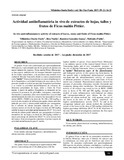| dc.rights.license | http://creativecommons.org/licenses/by-nc-sa/3.0/ve/ | es_VE |
| dc.contributor.author | Villalobos Osorio, Darly Coromoto | |
| dc.contributor.author | Rios, Nurby | |
| dc.contributor.author | Ramírez González, Irama Judith | |
| dc.contributor.author | Meléndez, Pablo | |
| dc.date.accessioned | 2018-07-23T21:17:20Z | |
| dc.date.available | 2018-07-23T21:17:20Z | |
| dc.date.issued | 2017 | |
| dc.identifier.issn | 0543-517X | |
| dc.identifier.uri | http://www.saber.ula.ve/handle/123456789/45136 | |
| dc.description.abstract | El género Ficus está conformado por aproximadamente
800 especies, representando uno de los géneros de plantas con
mayor número de especies. Ficus maitin Pittier (Moraceae)
es una especie endémica de los bosques húmedos tropicales
de los Andes venezolanos, y de presencia muy notable en la
ciudad de Mérida-Venezuela donde se conoce popularmente
como “maitin”. Hasta el momento no se conoce ningún aspecto
de la fitoquímica y actividad biológica de esta especie. En el
presente estudio se realizó un tamizaje fitoquímico preliminar
y se evaluó la actividad antiinflamatoria de extractos de
diferentes polaridades de hojas, tallos y frutos de Ficus
maitin. A partir de análisis fitoquímico se demostró en los
extractos la presencia de glicósidos, triterpenos, esteroides,
flavonoides y cumarinas, entre otros metabolitos. La actividad
antiinflamatoria de todos los extractos fue ensayada in vivo en
ratones BIOU: NMRI a las dosis de 50, 100 y 200 mg/Kg, a
través de dos modelos de inflamación aguda: edema auricular
inducido por xilol y edema podal inducido por carragenina.
En el método de edema auricular inducido por xilol el
extracto acuoso en frio de las hojas a la dosis de 200 mg/Kg
exhibió la mayor actividad antiinflamatoria (91,57 %) y en el
método de edema podal inducido por carragenina el extracto
metanólico de las hojas a la dosis de 200 mg/Kg exhibió el
mayor porcentaje de inhibición (86,67 %) en la tercera hora
del ensayo. Esta investigación constituye el primer reporte de
actividad antiinflamatoria para F. maitin. | es_VE |
| dc.language.iso | es | es_VE |
| dc.publisher | SaberULA | es_VE |
| dc.rights | info:eu-repo/semantics/openAccess | es_VE |
| dc.subject | Ficus maitin | es_VE |
| dc.subject | Tamizaje fitoquímico | es_VE |
| dc.subject | Antiinflamatorio | es_VE |
| dc.subject | Edema auricular | es_VE |
| dc.subject | Edema podal | es_VE |
| dc.title | Actividad antiinflamatória in vivo de extractos de hojas, tallos y frutos de Ficus maitin Pittier | es_VE |
| dc.title.alternative | In vivo anti-inflammatory activity of extracts of leaves, stems and fruits of Ficus maitin Pittier | es_VE |
| dc.type | info:eu-repo/semantics/article | es_VE |
| dcterms.dateAccepted | Diciembre 2017 | |
| dcterms.dateSubmitted | Octubre 2017 | |
| dc.description.abstract1 | The genus Ficus is shaped up of approximately 800
species, representing one of the plant genera with the
highest number of species. Ficus maitin Pittier (Moraceae)
is an endemic species of the tropical humid forests of the
Venezuelan Andes, and of very remarkable presence in
the city of Mérida-Venezuela, where it is popularly known
as “maitin”. Until now no aspect of the phytochemistry
and biological activity of this species has been known. In
the present study a preliminary phytochemical screening
was done and the antiinflammatory activity of extracts
of different polarities of leaves, stems and fruits of Ficus
maitin was evaluated. Phytochemical analysis showed the
presence of glycosides, triterpenes, steroids, flavonoids and
coumarins, among other metabolites. The antiinflammatory
activity of all extracts was tested in vivo in BIOU: NMRI
mice at doses of 50, 100 and 200 mg/Kg, through two
models of acute inflammation: xylol-induced ear edema
and carrageenan-induced paw edema. In the xylolinduced
ear edema method, the cold aqueous extract of
the leaves at the dose of 200 mg/Kg exhibited the
highest antiinflammatory activity (91.57 %) and in the
carrageenan induced paw edema method the methanolic
extract of the leaves at the dose of 200 mg/Kg exhibited the
highest percentage inhibition (86.67 %) in the third hour of
the trial. The present investigation constitutes the first report
of anti-inflammatory activity for F. maitin. | es_VE |
| dc.description.colacion | 16-23 | es_VE |
| dc.description.frecuencia | Semestral | |
| dc.identifier.depositolegal | pp195802ME1003 | |
| dc.identifier.edepositolegal | ppi201202ME4102 | |
| dc.identifier.eissn | 2244-8845 | |
| dc.publisher.pais | Venezuela | es_VE |
| dc.subject.facultad | Facultad de Farmacia y Bioanálisis | es_VE |
| dc.subject.keywords | Ficus maitin | es_VE |
| dc.subject.keywords | Phytochemical screnning | es_VE |
| dc.subject.keywords | Antiinflammatory | es_VE |
| dc.subject.keywords | Ear edema | es_VE |
| dc.subject.keywords | Paw edema | es_VE |
| dc.subject.publicacionelectronica | Revista de la Facultad de Farmacia | |
| dc.subject.seccion | Revista de la Facultad de Farmacia: Artículos Originales | es_VE |
| dc.subject.thematiccategory | Medicina y Salud | es_VE |
| dc.subject.tipo | Revistas | es_VE |
| dc.type.media | Texto | es_VE |


